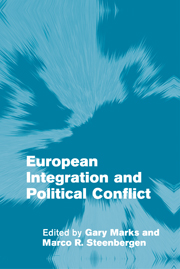Book contents
- Frontmatter
- Contents
- List of figures
- List of tables
- List of contributors
- Preface
- Introduction: Models of political conflict in the European Union
- Part I Citizens
- Part II Political parties
- 5 Defining the EU political space: an empirical study of the European election manifestos, 1979–1999
- 6 Does left/right structure party positions on European integration?
- 7 Political competition in the European Parliament: evidence from roll call and survey analyses
- 8 Contesting Europe? The salience of European integration as a party issue
- Part III Groups
- References
- Index
5 - Defining the EU political space: an empirical study of the European election manifestos, 1979–1999
Published online by Cambridge University Press: 22 September 2009
- Frontmatter
- Contents
- List of figures
- List of tables
- List of contributors
- Preface
- Introduction: Models of political conflict in the European Union
- Part I Citizens
- Part II Political parties
- 5 Defining the EU political space: an empirical study of the European election manifestos, 1979–1999
- 6 Does left/right structure party positions on European integration?
- 7 Political competition in the European Parliament: evidence from roll call and survey analyses
- 8 Contesting Europe? The salience of European integration as a party issue
- Part III Groups
- References
- Index
Summary
As Steenbergen and Marks (Introduction) describe, scholars of EU policy-making have adopted conflicting assumptions about the dimensionality and character of the EU policy space. Since the shape of the political space – the number of dimensions, the policy content of these dimensions, and the location of actors in this space – is a central determinant of political competition and outcomes, these conflicting assumptions often lead to different conclusions about and interpretations of EU policy-making. This is a serious impediment to advancing our theoretical understanding of EU politics. A resolution of this theoretical conflict depends on assessing the relative value of the conflicting assumptions about the character of the policy space.
To help address this problem, we attempt to examine empirically whether the structure of the EU political space is consistent with these existing models. Specifically, we investigate whether the existing models described by Marks and Steenbergen (in this book) account for the EU policy space as defined by the European party federations – or “Euro-parties.” These Euro-parties bring together the domestic and European-level political elites in the four main European party families – socialists, Christian democrats/conservatives, liberals, and greens. In the European elections of 1979, 1984, 1989, 1994, and 1999, the Euro-parties drafted manifestos describing their positions across a broad range of policies involving the EU. We use an established content analysis technique to turn these text documents into numerical data representing Euro-parties' positions on specific political issues.
- Type
- Chapter
- Information
- European Integration and Political Conflict , pp. 93 - 119Publisher: Cambridge University PressPrint publication year: 2004
- 19
- Cited by



